American Journal of Analytical Chemistry
Vol.5 No.8(2014), Article ID:46560,12 pages
DOI:10.4236/ajac.2014.58054
Production of Hydrogen: Photocatalytic Decomposition of Dimethyl Ether over Metal-Promoted TiO2 Catalysts
Gyula Halasi, Gábor Schubert, Frigyes Solymosi
MTA-SZTE Reaction Kinetics and Surface Chemistry Research Group, Szeged, Hungary
Email: fsolym@chem.u-szeged.hu
Copyright © 2014 by authors and Scientific Research Publishing Inc.
This work is licensed under the Creative Commons Attribution International License (CC BY).
http://creativecommons.org/licenses/by/4.0/



Received 12 April 2014; revised 16 May 2014; accepted 23 May 2014
ABSTRACT
The photo-induced vapor-phase decomposition of dimethyl ether was investigated on Pt metals deposited on pure and N-doped TiO2. Infrared spectroscopic measurements revealed that adsorption of dimethyl ether on TiO2 samples underwent partial dissociation to methoxy species. Illumination of the (CH3)2O-TiO2 and (CH3)2O-M/TiO2 systems led to the conversion of methoxy into adsorbed formate. In the case of metal-promoted TiO2 catalysts, CO bonded to the metals was also detected. Pure titania exhibited a very little photoactivity. Deposition of Pt metals on TiO2 markedly enhanced the extent of photocatalytic decomposition of dimethyl ether to give H2 and CO2 as the major products. A small amount of CO and methyl formate was also identified in the products. The most active metal was the Rh followed by Pd, Ir, Pt and Ru. When the bandgap of TiO2 was lowered by N-doping, the photocatalytic activity of metal/TiO2 catalysts appreciably increased. The effect of metals was explained by a better separation of charge carriers induced by illumination and by enhanced electronic interaction between metal nanoparticles and TiO2.
Keywords:Dimethyl Ether, Photocatalytic Decomposition, Production of Hydrogen, TiO2, Pt Metals, Doping TiO2 with N

1. Introduction
The production of H2, with a small amount of CO, is an important project for heterogeneous catalysis. In principle, the decomposition of methane and hydrocarbons seems to be a suitable process, but the carbon formed poisons the catalyst in early phase of the reaction [1] -[3] . More frequently used sources of H2 are ethanol, methanol and formic acid [4] [5] . For the generation of H2, almost free of CO formic acid is proved to be the more suitable compound [6] -[11] . However, the decomposition of all these compounds occurs at relatively high temperatures at 473 - 673 K even on the most active Pt metals. Illumination of the substrat-catalyst system, however, initiates their decomposition at room temperature [12] -[14] . The primary aim of the present work is to examine the photocatalytic decomposition of dimethyl ether (DME) on TiO2-supported Pt metals, and to explore the best experimental conditions for the production of hydrogen. Attention is paid to the identification of surface compounds formed during the illumination, to the effect of water and to the photocatalytic reaction in the visible light. Although the thermal catalytic decomposition of DME has been the subject of several studies [15] -[25] , this is the first work dealing with the photocatalytic decomposition of DME. Note that the H/C and H/O ratios are the same as in the ethyl alcohol, which is the most frequently used compound for the production of hydrogen.
DME is emerging as a replacement for diesel fuel due to its low NOx emission, and near-zero smoke compared with traditional diesel fuels [26] [27] . DME, which was pointed out recently by Oláh [28] , besides being the excellent transportation fuel, also allows storage of hydrogen and thus energy. As many important chemicals can be prepared from DME, it is perspicuous that its reactions have been the subject of the extensive research. This includes its combustion, selective oxidation to light olefins and formaldehyde, and transformation to hydrocarbons [28] [29] .
2. Experimental
2.1. Methods
Photocatalytic reaction was followed in the same way as described in our previous papers [14] . We used a 15 W germicide lamp (type GCL 307T5L/CELL, Lighttech Ltd., Hungary), which emits predominantly in the wavelength range of 250 - 440 nm, its maximum intensity is at 254 nm. For the visible photocatalytic experiments another type of lamp was used (Lighttech GCL 307T5L/GOLD) with 400 - 640 nm wavelength range and two maximum intensities at 453 and 545 nm. Note that this lamp also emits below 400 nm. The approximate light intensity at the catalyst films is 3.9 mW/cm2 for the germicide lamp and 2.1 mW/cm2 for the other lamp. The photoreactor (volume: 670 ml) consists of two concentric quartz glass tubes fitted one into the other and a centrally positioned lamp. It is connected to a gas-mixing unit serving for the adjustment of the composition of the gas or vapor mixtures to be photolyzed in situ. The carrier gas was Ar, which was mixed with DME (~1.5%, 330 μmol). The DME/water-containing Ar flow entered the reactor through an externally heated tube to avoid condensation. The gas-mixture was circulated by a diaphragm pump. The reaction products were analyzed with a HP 5890 gas chromatograph equipped with PORAPAK Q and PORAPAK S packed columns. The sampling loop of the GC was 500 μl. The amount of all products was related to this loop. The conversion of DME was mainly calculated taking into account the amount of DME consumed.
For FTIR studies a mobile IR cell housed in a metal chamber was used [14] . Samples were illuminated by the full arc of a Hg lamp (LPS-220, PTI) outside the IR sample compartment. The filtered light passed through a high-purity CaF2 window into the cell. Infrared spectra were recorded with a Biorad (Digilab. Div. FTS 155) instrument. All the spectra presented in this study are difference spectra. The surface area of the catalysts was determined by BET method with N2 adsorption at ~100 K. The dispersion of metals was determined by the adsorption of H2 at room temperature.
2.2. Materials
TiO2 of different origins was used: Hombikat, UV 100 (pure anatase, 300 m2/g), TiO2 nanowire (60 m2/g) and nanotube (40 m2/g). The synthesis of the last two compounds is described elsewhere [30] . For the preparation of N-doped samples TiO2 was reacted with NH3 [31] [32] . Titanium tetrachloride was used as a precursor. After several steps the NH3-treated TiO2 slurry was vacuum dried at 353 K for 12 hr, followed by calcination at 723 K in flowing air for 3 hr. This TiO2 is noted with “SX”. The surface area of TiO2 prepared in this way is 265 m2/g and that of N-doped oxide is 79 m2/g. The nitrogen content of this sample is 2.9%. The bandgaps of these TiO2 samples have been evaluated in our previous work [14] . We obtained 3.02 eV for pure TiO2 and 1.98 eV for N-doped TiO2. Metal-promoted TiO2 samples were prepared by impregnating pure or doped TiO2 with the solution of metal compounds to yield a nominal 2 wt% metal. The following salts of Pt metals were used: Pd(NO3)2, H2IrCl6, RhCl3∙3H2O, H2PtCl6∙6H2O and RuCl3∙3H2O. For IR studies the samples were pressed in self-supporting wafers (30 × 10 mm ~10 mg/cm2). For photocatalytic measurements the sample (70 - 80 mg) was sprayed onto the outer side of the inner tube from aqueous suspension. The surface of the catalyst film was 168 cm2. The catalysts were oxidized and reduced at 573 K in the IR cell or in the catalytic reactor for 1 hr. DME was the product of Gerling Holz Co. with purity of 99.9%.
3. Results
3.1. FTIR Study of Photolysis of DME
The primary aim of IR study is to ascertain the development of adsorbed complexes formed on the effect of illumination on TiO2, and to establish the influence of metal deposition on these features. Exposing pure TiO2 to DME at 300 K resulted in a development of intense absorption bands in the C-H stretching region at 2950, 2921, 2878, 2842 and ~2830 cm−1 (Figure 1). In the low frequency range strong bands appeared at 1459, 1253, 1159 and ~1063 cm−1. Weaker bands or shoulder were also traced at ~1592 and ~1384 cm−1. Illumination of the adsorbed DME caused only very slight changes in the high frequency range, but led to the slow attenuation of the bands at 1459 and 1253 cm−1. At the same time the absorption peaks at ~1585 and 1366 cm−1 increased in intensity. These spectral features were also observed on the IR spectra of metal/TiO2 samples (Figure 2). In the high frequency range a pair of strong absorption bands at 2948 - 2952 and 2833 - 2838 cm−1 of almost same intensity became the dominant spectral features for all M/TiO2 catalysts. In the low frequency range the absorption features at ~1458, 1253, 1153 and 1047 - 1056 cm−1 were found. We obtained similar spectral features for Ir/TiO2 (not presented). The effect of the illumination on the IR spectra was almost the same as observed for pure TiO2. The difference was the appearance of a shoulder at 2936 cm−1 and the development of an intense CO band between 2001 - 2078 cm−1, which grew slightly with the progress of illumination. In the low frequency range new strong absorption features appeared at ~1570 - 1574 and ~1357 cm−1. IR bands observed on different samples and their assignments are presented in Table 1.
3.2. Catalytic Studies in UV Light
The photocataytic decomposition of DME has been investigated on different TiO2 samples. Whereas DME does not decompose at 300 K on pure TiO2, illumination induced the occurrence of the reaction to give H2 and CO2.
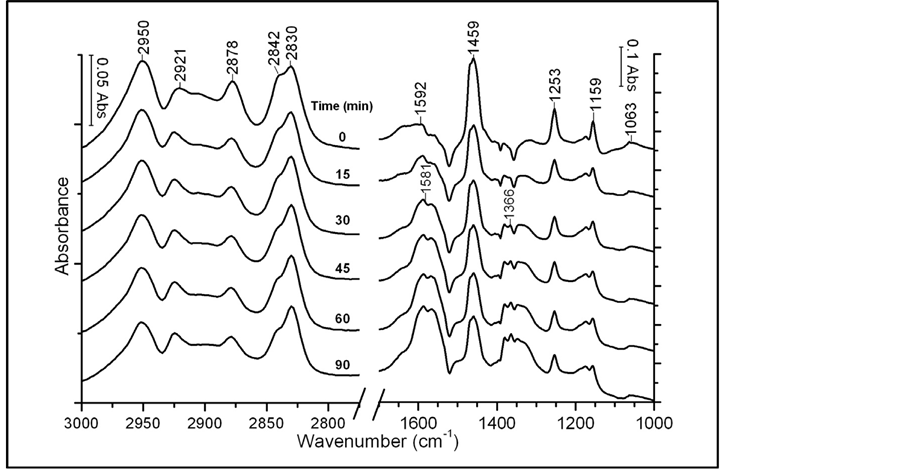
Figure 1. Effects of illumination time on the FTIR spectra of adsorbed dimethyl ether on TiO2 (Hombikat).
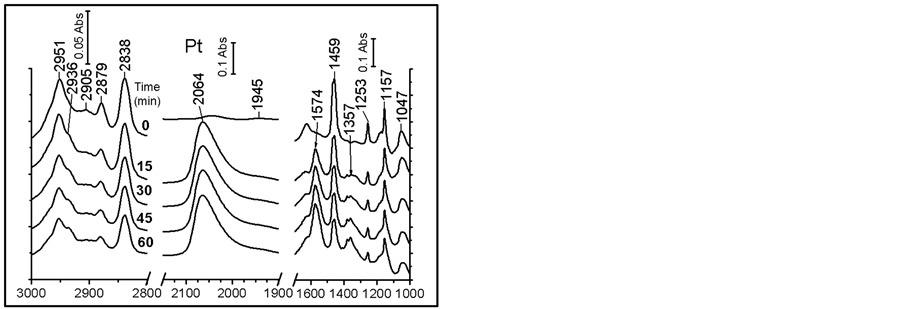 (a)
(a) (b)
(b) (c)
(c)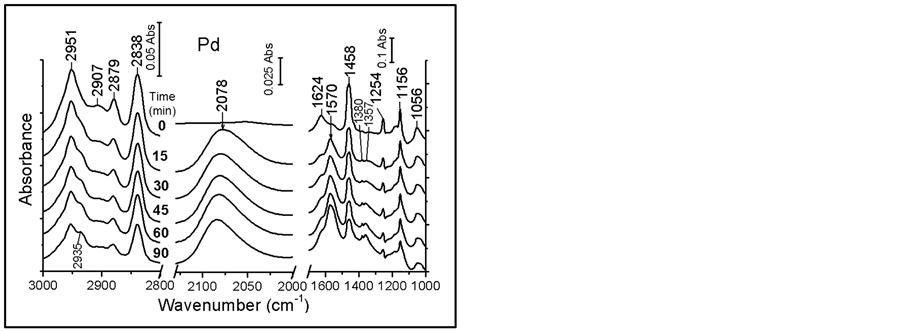 (d)
(d)
Figure 2. Effects of illumination time on the FTIR spectra of adsorbed dimethyl ether on Rh/TiO2 (a), Pt/TiO2 (b), Pd/TiO2 (c) and Ru/TiO2 (d) at 300 K.
Table 1. Characteristic absorption bands (cm−1) following the adsorption of dimethyl ether, methanol and formic acid on various solids.
(g) gaseous; (a) adsorbed.
However even on the most effective TiO2 (Hombikat) the extent of the decomposition was very low, about ~2% - 3%, in 210 min. The photocatalytic effect of TiO2 nanowire and nanotubes was also tested: we obtained a similar low photoactivity.
The deposition of Pt metals on TiO2 (Hombikat) markedly enhanced its photoactivity. In Figure 3, we displayed the conversion of DME and the amount of products formed on various catalysts as a function of illumination time. On the most active Rh/TiO2, the conversion of the decomposition of DME attained ~22% in 210 min. On the less active Ru/TiO2 it was only ~6.5%. The main products were H2 and CO2. A small amount of CO and methyl formate was also formed. A trace of formaldehyde was also detected. The CO/H2 ratio varied between ~0.023 - 0.044. The formation of methyl formate deserves a special attention. Its amount increased with the illumination time (Figure 4(a)). The largest quantity was measured for Rh/TiO2 and the lowest one for Pt/TiO2. When its amount was related to that of H2 produced, we obtained the highest value for Ru/TiO2. The ratio of methyl formate/H2 slowly decreased with the duration of illumination (Figure 4(b)). Some important data for the photocatalytic decomposition of DME are presented in Table 2. Based on the conversion data, the activity order of metals was as follows: Rh, Pd, Ir, Pt and Ru. When the rate of H2 production is related to the dispersity of the metals, we obtained slightly different order: Pt, Rh, Pd, Ir and Ru.
In order to judge the contribution of thermal effect for the photoreaction, we also examined the thermal reaction on selected catalysts. A measurable reaction on Pt/TiO2 and Rh/TiO2 was observed only at 523 K. Attaching a thin thermocouple in the catalyst layer indicated only a temperature rise of only a few degrees during illumination. The results of these control experiments lead us to exclude the contribution of thermal effects to the photodecomposition of DME induced by illumination.
 (a)
(a) (b)
(b)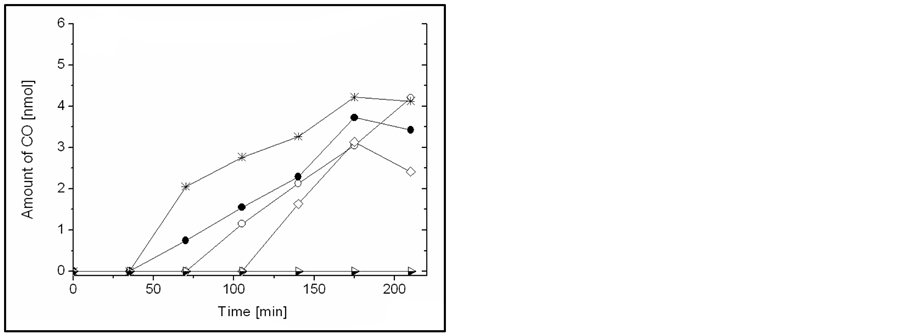 (c)
(c)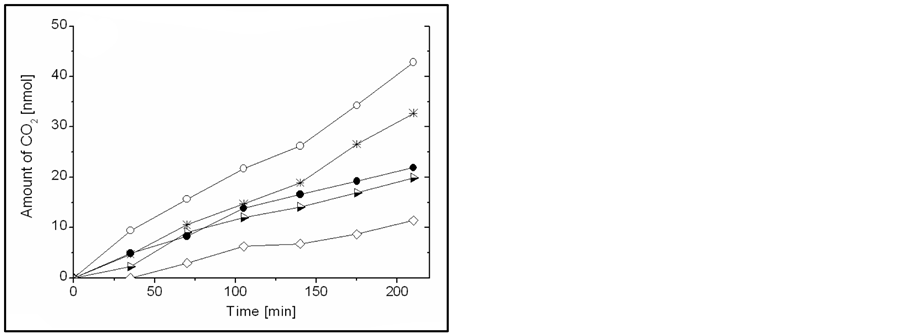 (d)
(d)
Figure 3. Effects of different Pt metals deposited on TiO2 (Hombikat) on the photocatalytic decomposition of dimethyl ether. Conversion (a), formation of H2 (b), CO2 (c) and CO (d).
Table 2. Some characteristic data for the photolysis of DME on metal-promoted TiO2.
 = the amount of H2 formed in 210
min related to the number of metal atoms.
= the amount of H2 formed in 210
min related to the number of metal atoms.
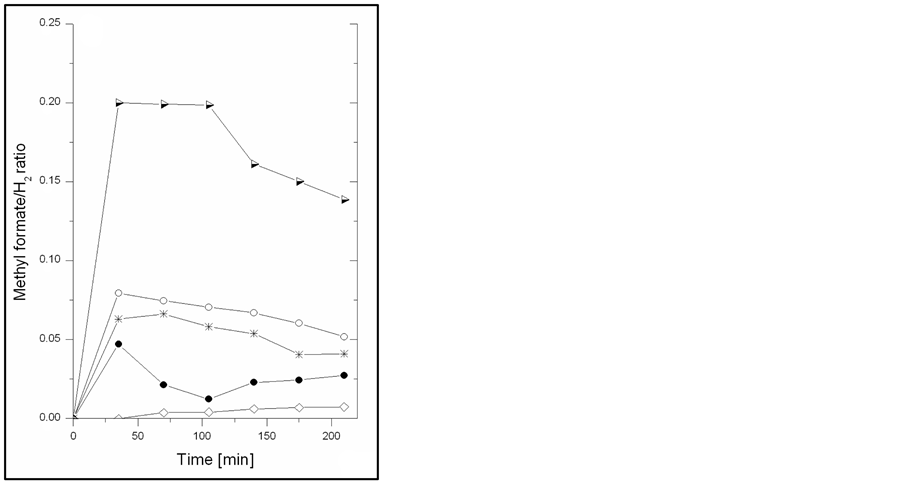 (a)
(a)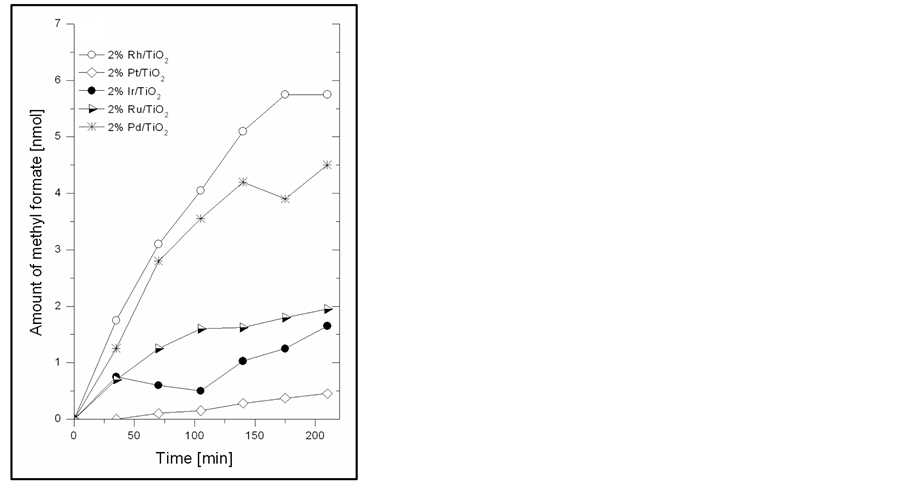 (b)
(b)
Figure 4. Effects of illumination time on the formation of methyl formate (a) and on the methyl formate/H2 ratio (b) on TiO2-supported Pt metals.
The effect of illumination on the reforming of DME was also investigated. Water exerted a positive influence on the conversion of DME and it appreciably increased the amount of H2 formed. As the hydrolysis of DME to CH3OH occurs more easily on the acidic centers of Al2O3, some experiments have been performed in the presence of Al2O3. Adding Al2O3 to Pd/TiO2 catalyst greatly enhanced the conversion of DME and the formation of H2. Table 3 contains some characteristic data.
3.3. Catalytic Studies in Visible Light
Some experiments have been performed in visible light. These measurements were carried out with TiO2 (SX), which possessed better performance compared to other N-doped TiO2 [14] . As the surface area of TiO2 is markedly lowered by doping with N, the data presented in Figure 5 are related to unit surface area. The results clearly show that whereas pure TiO2 exhibits very little activity in the visible light, the photoactivity of N-doped sample (SX) is appreciably higher. Similar features were experienced for metal-promoted TiO2. Figure 6 depicts the photocatalytic effects of three selected metals deposited on pure and N-doped TiO2 (SX). A comparison immediately reveals that the photoactivity of the metals on N-doped sample is markedly higher than that of M/TiO2 free of nitrogen. This is reflected in the conversion of DME and in the amounts of the products formed in the photo-induced decomposition.
Table 3 . Effects of H2O and Al2O3 on the product distribution of photocatalytic decomposition of DME on Pd/TiO2 samples. Data refer to reaction time of 210 min.
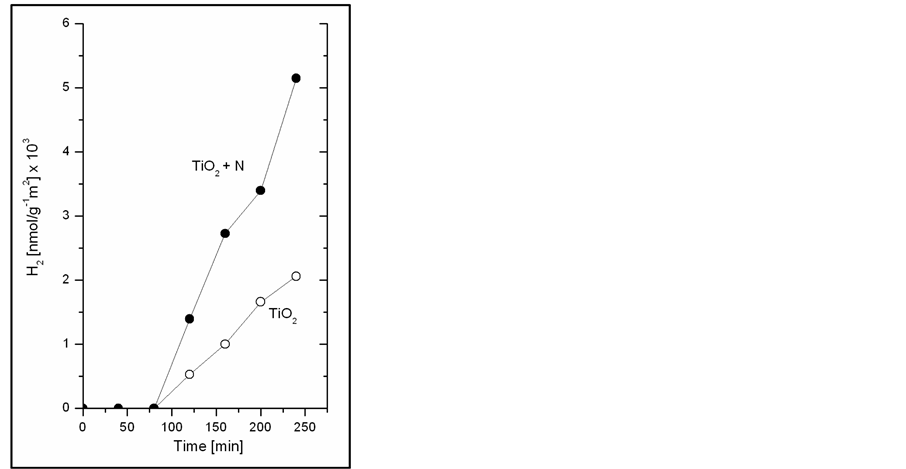
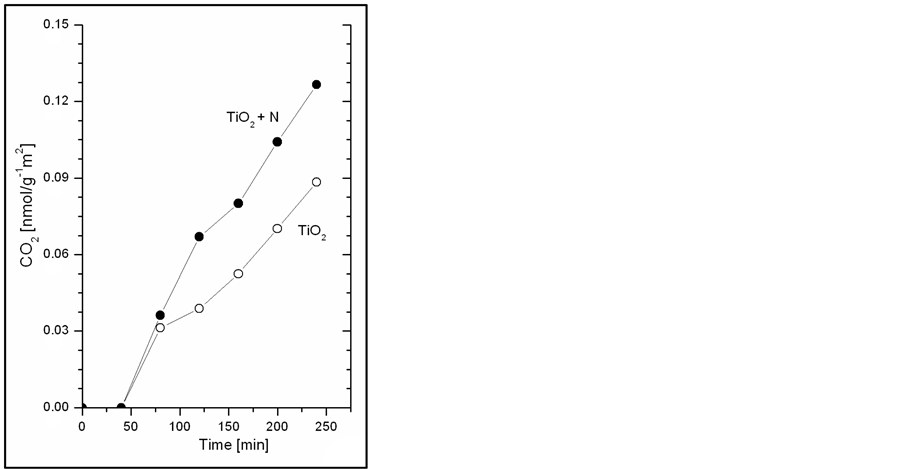
Figure 5. Photocatalytic decomposition of dimethyl ether on pure and N-doped TiO2 samples (SX) in visible light.
4. Discussion
4.1. IR Studies
Adsorption of DME on TiO2 at 300 K produced several intense absorption bands in the IR spectra. Taking into account the results of previous studies their possible assignment is presented in Table 1. In the high frequency range a pair of strong absorption bands at ~2952 and 2838 cm−1 of almost same intensity became the dominant spectral features for pure and metal-promoted TiO2 catalysts. These absorption bands are the characteristic vibration of molecularly bonded DME. The dissociation of DME to CH3O species is indicated by the appearance of another pair of bands at 2936 and 2879 cm−1. The intensities of all these bands underwent a slight attenuation as a result of illumination. A more striking effect of photolysis of adsorbed DME is the appearance of asymmetric stretch of formate bands at ~1570 cm−1, and the development of CO band between 2000 - 2101 cm−1 on TiO2-supported metals. The fact that we observed the same spectral features for TiO2 and for M/TiO2 samples indicates that both the adsorbed DME and the CH3O species are located on the TiO2 surface. The appearance of CO band in the IR spectra of metal/TiO2 samples, however, suggests that the metals can initiate the decomposition of these compounds very likely resided at the metal/oxide interface. An interesting feature of the IR spectra is the absence of dicarbonyl species (M+(CO)2). This possible reason is that hydrogen formed in the photoreactions prevents the oxidative disruption of metal particles leading to the formation of M+(CO)2 surface complex [36] .
The formation of methoxy species suggests the breakage of one of the C-O bonds in the adsorbed DME
 (1)
(1)
As there it is no indication of the IR bands of adsorbed CH3 radical [37] , it is very likely that the CH3 has been attached to the oxygen atom of TiO2 also yielding a Ti-OCH3 surface compound. Accordingly, instead of step (1), we can count with the reaction of DME with the OH groups of TiO2
 (2)
(2)
Illumination of adsorbed layer resulted in a slow attenuation of methoxy bands and the appearance of absorption features due to formate species. Its formation is described by the following elementary steps
 (3)
(3)
 (4)
(4)
4.2. Catalytic Studies
DME proved to be very resistant towards illumination on TiO2. Deposition of Pt metals on the TiO2, however, enhanced its photoactivity, but the low reactivity of DME appeared on these catalysts, too. The effect of illumination can be explained by the donation of photoelectrons formed in the photo-excitation process
 (5)
(5)
to the CH3O species:
 (6)
(6)
producing a more reactive negatively charged species, which is converted into adsorbed CH2O and HCOO (Equations (3) and (4)). However, even the photo-induced reaction occurred to only a very limited extent on pure TiO2, a finding which can be attributed to the fast recombination of the electrons and holes formed in the photo-excitation process (Equation (5)). The formation of H2, CO2 and CO suggests the occurrence of the reactions
 (7)
(7)
 (8)
(8)
 (9)
(9)
An interesting and somewhat surprising result of the photocatalytic decomposition of DME is the formation of methyl formate. This compound has been considered as a precursor in the preparation of several materials [38] . Methyl formate is mainly synthesized by dehydrogenation of methanol over Cu-based catalyst at higher temperatures. However, recent works showed that it is also formed in the photocatalytic oxidation [39] and decomposition of methanol on polycrystalline TiO2 at room temperature [40] . Its production was markedly increased when Pt metals were deposited on TiO2 [40] . The highest yield of methyl formate was measured for Pt/TiO2 (62.2) and the lowest one for Ru/TiO2 (26.0). Recent studies performed under UHV conditions on preoxidized TiO2(110) disclosed that methyl formate is produced from the photo-oxidation of methanol even at ~200 K [41] . The finding that methyl formate is produced in the photocatalytic decomposition of DME further supports the idea that CH3O species is involved in its photoreaction The formation of methyl formate can be ascribed to the recombination of CH2O formed in the dissociation of CH3O (Equation (3)):
 (10)
(10)
or by the reaction of CH2O with a further CH3O species:
 (11)
(11)
An appreciable increase in the extent of photolysis of DME was observed in the presence of H2O, which can be attributed to the occurrence of the hydrolysis of DME,
 (12)
(12)
e.g. to the formation of more reactive CH3OH. The addition of H2O to DME also lowered the extent of CO formation, very likely due to the occurrence of the water-gas shift reaction promoted by illumination. This was confirmed by a separate experiment. Mixing Pd/TiO2 with Al2O3 further enhanced the formation of H2, which can be also ascribed to the promotion of the hydrolysis of DME to methanol.
The deposition of metals onto TiO2 greatly improved the photocatalytic effect of the TiO2. We assume that the CH3O species formed at the metal/TiO2 interface is much more reactive than that located on TiO2. The promoting effect of Pt metals deposited on TiO2 is generally explained by the better charge carrier separation induced by illumination [12] [13] [42] . In addition we assume that the occurrence of an electronic interaction between n-type TiO2 and Pt metals is also important. The role of the electronic interaction between metals and TiO2 has been first demonstrated in the catalytic decomposition of formic acid on Ni deposited on pure and doped TiO2 [43] [44] . As far as we are aware, TiO2 was first used as a support in this case [43] . As the work function of TiO2 (~4.6 eV) is less than that of Pt metals (4.7 - 5.7 eV), electron transfer is expected to occur from TiO2 to the deposited metals, which increases the activation of adsorbed molecules. We assume that illumination enhances the extent of this electron transfer at the interface of the two solids, leading to increased decomposition.
An important finding of this work is that the incorporation of N into TiO2 support enhanced the photoactivity of TiO2 (Figure 5), and particularly that of M/TiO2 catalysts (Figure 6) and led to the decomposition of DME in the visible light, too. This can be attributed to the lowering of the bandgap of TiO2.
4.3. Comparison of the Reactivity of Various Organic Compounds
As we studied the photocatalytic decomposition of several organic compounds on the same catalysts under exactly identical experimental conditions, this gives us a possibility to make a comparison. Some data are presented in Table 4. It shows that HCOOH is the most reactive compound both on TiO2 and Rh/TiO2. H2 was also formed with highest selectivity and yield in the photocatalytic decomposition of HCOOH. Relatively high yield for H2 formation was obtained in the decomposition of C2H5OH on Rh/TiO2.
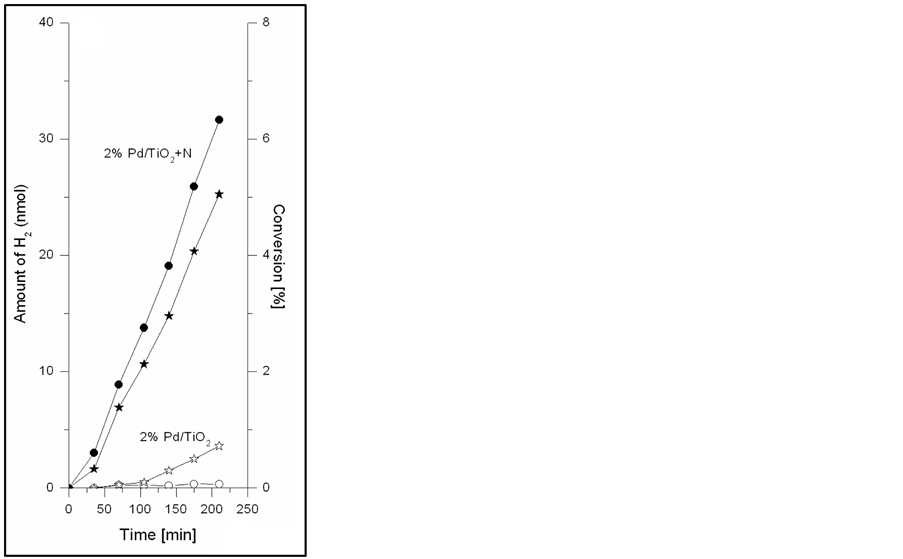 (a)
(a)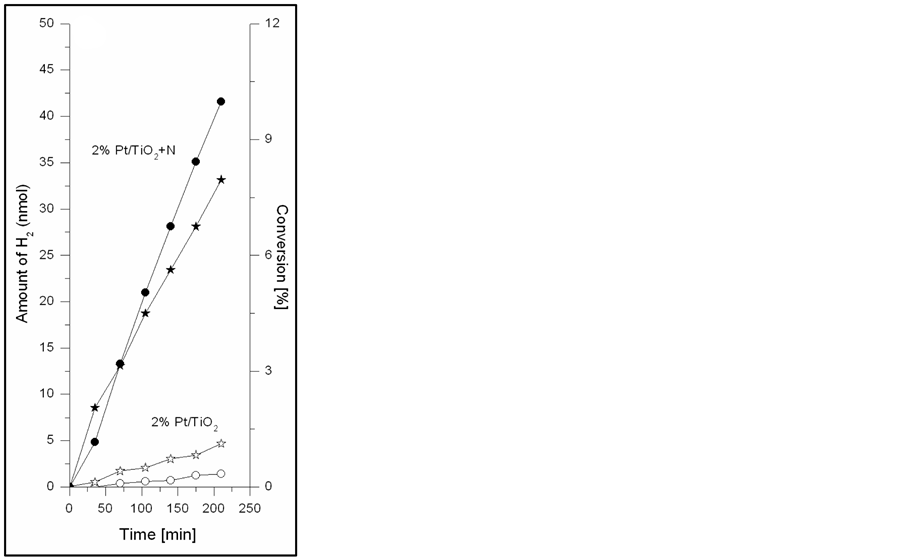 (b)
(b)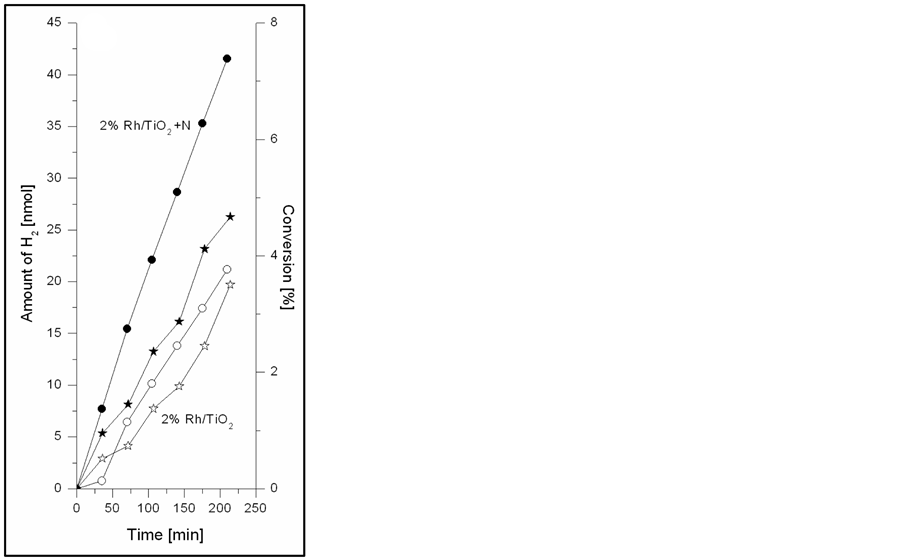 (c)
(c)
Figure 6. Effects of N-doping of TiO2 (SX) on the photocatalytic decomposition of dimethyl ether on 2% Rh/TiO2 (a), 2% Pt/TiO2 (b), and 2% Pd/TiO2 (c) in visible light. ○ ☆ TiO2, ● « TiO2 + N, ☆ « conversion, ○ ● H2 formation.
Table 4. Comparison of the results obtained in the photocatalytic decomposition of various compounds.
5. Conclusions
• IR spectroscopic study revealed that a fraction of adsorbed DME underwent the dissociation to methoxy species on TiO2 at 300 K.
• Illumination of adsorbed DME leads to the generation of formate species, and to the formation of CO bonded to Pt metals.
• Photocatalytic decomposition of DME on TiO2 is a very limited process.
• Deposition of Pt metals on TiO2 markedly enhanced the extent of photocatalytic reaction.
• Lowering the bandgap of TiO2 by N doping appreciably increased the photocatalytic activity of metal/TiO2 catalysts.
Acknowledgements
This work was supported by the grant OTKA under contract number K 81517 and TÁMOP under contract number 4.2.2.A-11/1/KONV-2012-0047.
References
- Sandstede, G. (1992) Decomposition of Hydrocarbons into Hydrogen and Carbon for the CO2-Free Production of Hydrogen. 9th World Hydrogen Energy Conference, Paris, 22-25 June 1992, 1745.
- Haryanto, A., Fernando, S., Murali, N. and Adhikari, S. (2005) Current Status of Hydrogen Production Techniques by steam Reforming of Ethanol: A Review. Energy Fuels, 19, 2098-2106. http://dx.doi.org/10.1021/ef0500538
- Muradov, N. (2001) Catalysis of Methane Decomposition over Elemental Carbon. Catalysis Communications, 2, 89-94. http://dx.doi.org/10.1016/S1566-7367(01)00013-9
- Mariňo, F., Boveri, M., Baronetti, G. and Laborde, M. (2001) Hydrogen Production from Steam Reforming of Bioethanol Using Cu/Ni/K/γ-Al2O3 Catalysts. Effect of Ni. International Journal of Hydrogen Energy, 26, 665-668. http://dx.doi.org/10.1016/S0360-3199(01)00002-7
- Diagne, C., Idriss, H. and Kiennemann, A. (2002) Hydrogen Production by Ethanol Reforming over Rh/CeO2-ZrO2 Catalysts. Catalysis Communications, 3, 565-571. http://dx.doi.org/10.1016/S1566-7367(02)00226-1
- Ojeda, M. and Iglesia, E. (2009) Formic Acid Dehydrogenation on Au-Based Catalysts at Near-Ambient Temperatures. Angewandte Chemie International Edition, 48, 4800-4803. http://dx.doi.org/10.1002/anie.200805723
- Koós, Á. and Solymosi, F. (2010) Production of CO-free H2 by Formic Acid Decomposition over MO2C/Carbon Catalysts. Catalysis Letters, 138, 23-27. http://dx.doi.org/10.1007/s10562-010-0375-3
- Bulushev, D.A., Beloshapkin, S. and Ross, J.R.H. (2010) Hydrogen from Formic Acid Decomposition over Pd and Au Catalysts. Catalysis Today, 154, 7-12. http://dx.doi.org/10.1016/j.cattod.2010.03.050
- Zhou, X., Huang, Y., Xing, W., Liu, C., Liao, J. and Lu, T. (2008) High-Quality Hydrogen from the Catalyzed Decomposition of Formic Acid by Pd-Au/C and Pd-Ag/C. Chemical Communications, 3540-3542. http://dx.doi.org/10.1039/b803661f
- Solymosi, F., Koós, Á., Liliom, N. and Ugrai, I. (2011) Production of CO-free H2 from Formic Acid. A Comparative Study of the Catalytic Behaviour of Pt Metals on a Carbon Support. Journal of Catalysis, 279, 213-219. http://dx.doi.org/10.1016/j.jcat.2011.01.023
- Gazsi, A., Bánsági, T. and Solymosi, F. (2011) Decomposition and Reforming of Formic Acid on Supported Au Catalysts: Production of CO-Free H2. Journal of Physical Chemistry C, 115, 15459-15466. http://dx.doi.org/10.1021/jp203751w
- Linsebigler, A., Lu, G. and Yates, Jr., J.T. (1995) Photocatalysis on TiO2 Surfaces: Principles, Mechanisms, and Selected Results. Chemical Reviews, 95, 735-758. http://dx.doi.org/10.1021/cr00035a013
- Hoffmann, M.R., Martin, S.T., Choi, W. and Bahnemann, D.W. (1995) Environmental Applications of Semiconductor Photocatalysis. Chemical Reviews, 95, 69-96. http://dx.doi.org/10.1021/cr00033a004
- Halasi, Gy., Schubert, G. and Solymosi, F. (2012) Photodecomposition of Formic Acid on N-Doped and Metal-Promoted TiO2. Production of CO-Free H2. Journal of Physical Chemistry C, 116, 15396-15405. http://dx.doi.org/10.1021/jp3030478
- Galvita, V.V., Semin, G.L., Belyaev, V.D., Yurieva, T.M. and Sobyanin, V.A. (2001) Production of Hydrogen from Dimethyl Ether. Applied Catalysis A: General, 216, 85-90. http://dx.doi.org/10.1016/S0926-860X(01)00540-3
- Takeishi, K. and Suzuki, H. (2004) Steam Reforming of Dimethyl Ether. Applied Catalysis A: General, 260, 111-117. http://dx.doi.org/10.1016/j.apcata.2003.10.006
- Nishiguchi, T., Oka, K., Matsumoto, T., Kanai, H., Utani, K. and Imamura, S. (2004) Durability of WO3/ZrO2- CuO/CeO2 Catalysts for Steam Reforming of Dimethyl Ether. Applied Catalysis A: General, 301, 66-74. http://dx.doi.org/10.1016/j.apcata.2005.11.011
- Faungnawakij, K., Tanaka, Y., Shimoda, N., Fukunaga, T., Kawashima, S., Kikuchi, R. and Eguchi, K. (2006) Influence of Solid-Acid Catalysts on Steam Reforming and Hydrolysis of Dimethyl Ether for Hydrogen Production. Applied Catalysis A: General, 304, 40-48. http://dx.doi.org/10.1016/j.apcata.2006.02.021
- Kawabata, T., Matsuoka, H., Shishido, T., Li, D., Tian, Y., Sano, T. and Takehira, K. (2006) Steam Reforming of Dimethyl Ether over ZSM-5 Coupled with Cu/ZnO/Al2O3 Catalyst Prepared by Homogeneous Precipitation. Applied Catalysis A: General, 308, 82-90. http://dx.doi.org/10.1016/j.apcata.2006.04.032
- Semelsberger, T.A., Ott, K.C., Borup, R.L. and Greene, H.L. (2005) Generating Hydrogen-Rich Fuel-Cell Feeds from Dimethyl Ether (DME) Using Physical Mixtures of a Commercial Cu/Zn/Al2O3 Catalyst and Several Solid-Acid Catalysts. Applied Catalysis B: Environmental, 65, 291-300. http://dx.doi.org/10.1016/j.apcatb.2006.02.015
- Fukunaga, T., Ryomon, N. and Shimazo, S. (2008) The Influence of Metals and Acidic Oxide Species on the Steam Reforming of Dimethyl Ether (DME). Applied Catalysis A: General, 348, 193-200. http://dx.doi.org/10.1016/j.apcata.2008.06.031
- Solymosi, F., Barthos, R. and Kecskeméti, A. (2008) The Decomposition and Steam Reforming of Dimethyl Ether on Supported Mo2C Catalysts. Applied Catalysis A: General, 350, 30-37. http://dx.doi.org/10.1016/j.apcata.2008.07.037
- Halasi, Gy., Bánsági, T. and Solymosi, F. (2009) Production of Hydrogen from Dimethyl Ether over Supported Rhodium Catalysts. ChemCatChem, 1, 311-317. http://dx.doi.org/10.1002/cctc.200900113
- Faungnawakij, K., Shimoda, N., Fukunaga, T., Kikuchi, R. and Eguchi, K. (2009) Crystal Structure and Surface Species of CuFe2O4 Spinel Catalysts in Steam Reforming of Dimethyl Ether. Applied Catalysis B: Environmental, 92, 341-350. http://dx.doi.org/10.1016/j.apcatb.2009.08.013
- Gazsi, A., Ugrai, I. and Solymosi, F. (2011) Production of Hydrogen from Dimethyl Ether on Supported Au Catalysts. Applied Catalysis A: General, 391, 360-366. http://dx.doi.org/10.1016/j.apcata.2010.04.054
- Rouhi, A.M. (1995) Underwater Chemistry Creates Massive Sea-Floor Mineral Deposits. Chemical & Engineering News, 73, 37-39. http://dx.doi.org/10.1021/cen-v073n050.p037
- Fleish, T.H., Basu, A., Gradassi, M.J. and Masin, J.G. (1997) Dimethyl Ether: A Fuel For The 21st Century. Studies in Surface Science and Catalysis, 107, 117-125. http://dx.doi.org/10.1016/S0167-2991(97)80323-0
- Olah, G.A. and Molnár, Á. (2003) Hydrocarbon Chemistry. Wiley, New York. http://dx.doi.org/10.1002/0471433489
- Kecskeméti, A., Barthos, R. and Solymosi, F. (2008) Aromatization of Dimethyl Ether and Diethyl Ether on Mo2C- Promoted ZSM-5 Catalysts. Journal of Catalysis, 258, 111-120.
- Wu, M.C., Tóth, G., Sápi, A., Leino, A.R., Kónya, Z., Kukovecz, Á., Su, W.F. and Kordás, K. (2012) Synthesis and Photocatalytic Performance of Titanium Dioxide Nanofibers and the Fabrication of Flexible Composite Films from Nanofibers. Journal of Nanoscience and Nanotecnology, 12, 1421-1424. http://dx.doi.org/10.1166/jnn.2012.4655
- Xu, J.H., Dai, W.L., Li, J., Cao, Y., Li, H., He, H. and Fan, K. (2008) Simple Fabrication of Thermally Stable Apertured N-doped TiO2 Microtubes as a Highly Efficient Photocatalyst under Visible Light Irradiation. Catalysis Communications, 9, 146-152. http://dx.doi.org/10.1016/j.catcom.2007.05.043
- Schubert, G., Bánsági, T. and Solymosi, F. (2013) Photocatalytic Decomposition of Methyl Formate over TiO2-Supported Pt Metals. Journal of Physical Chemistry C, 117, 22797-22804. http://dx.doi.org/10.1021/jp406840n
- Beebe Jr., T.P., Crowell, J.E. and Yates Jr., J.T. (1988) Reaction of Methyl Chloride with Alumina Surfaces: A Study of the Methoxy Surface Species by Transmission Infrared Spectroscopy. Journal of Physical Chemistry, 92, 1296-1301. http://dx.doi.org/10.1021/j100316a056
- Chen, J.G., Basu, P., Ballinger, T.H. and Yates Jr., J.T. (1989) A Transmission Infrared Spectroscopic Investigation of the Reaction of Dimethyl Ether with Alumina Surfaces. Langmuir, 5, 352-356. http://dx.doi.org/10.1021/la00086a011
- Busca, G., Elmi, A.S. and Forzatti, P. (1987) Mechanism of Selective Methanol Oxidation over Vanadium Oxide-Titanium Oxide Catalysts: A FT-IR and Flow Reactor Study. Journal of Physical Chemistry, 91, 5263-5269. http://dx.doi.org/10.1021/j100304a026
- Solymosi, F. and Pásztor, M. (1986) Infrared Study of the Effect of H2 on CO-Induced Structural Changes in Supported Rh. Journal of Physical Chemistry, 90, 5312-5317. http://dx.doi.org/10.1021/j100412a081
- Solymosi, F. and Klivényi, G. (1993) HREELS Study of CH3I and CH3 Adsorbed on Rh(111) Surface. Journal of Electron Spectroscopy and Related Phenomena, 64-65, 499-506. http://dx.doi.org/10.1016/0368-2048(93)80115-3
- Jenner, G. (1995) Homogeneous Catalytic Reactions Involving Methyl Formate. Applied Catalysis A: General, 121, 25-44. http://dx.doi.org/10.1016/0926-860X(95)85008-2
- Kominami, H., Sugahara, H. and Hashimoto, K. (2010) Photocatalytic Selective Oxidation of Methanol to Methyl Formate in Gas Phase over Titanium(Iv) Oxide in a Flow-Type Reactor. Catalysis Communications, 11, 426-429. http://dx.doi.org/10.1016/j.catcom.2009.11.014
- Halasi, G., Schubert, G. and Solymosi, F. (2012) Comparative Study on the Photocatalytic Decomposition of Methanol on TiO2 Modified by N and Promoted by Metals. Journal of Catalysis, 294, 199-206. http://dx.doi.org/10.1016/j.jcat.2012.07.020
- Phillips, K.R., Jensen, S.C., Baron, M., Li, S.C. and Friend, C.M. (2013) Sequential Photo-Oxidation of Methanol to Methyl Formate on TiO2(110). Journal of American Chemical Society, 135, 574-577. http://dx.doi.org/10.1021/ja3106797
- Connelly, K., Wahab, A.K. and Idriss, H. (2012) Photoreaction of Au/TiO2 for Hydrogen Production from Renewables: A Review on the Synergistic Effect between Anatase and Rutile Phases of TiO2. Materials for Renewable and Sustainable Energy, 1, 3.
- Szabó, Z.G. and Solymosi, F. (1961) Influence of the Defect Structure of Support on the Activity of Catalyst. Actes Du Deuxieme Congres International De Catalyse, Paris, July 1960, 1627-1651.
- Solymosi, F. (1968) Importance of the Electric Properties of Supports in the Carrier Effect. Catalysis Reviews, 1, 233- 255. http://dx.doi.org/10.1080/01614946808064705


